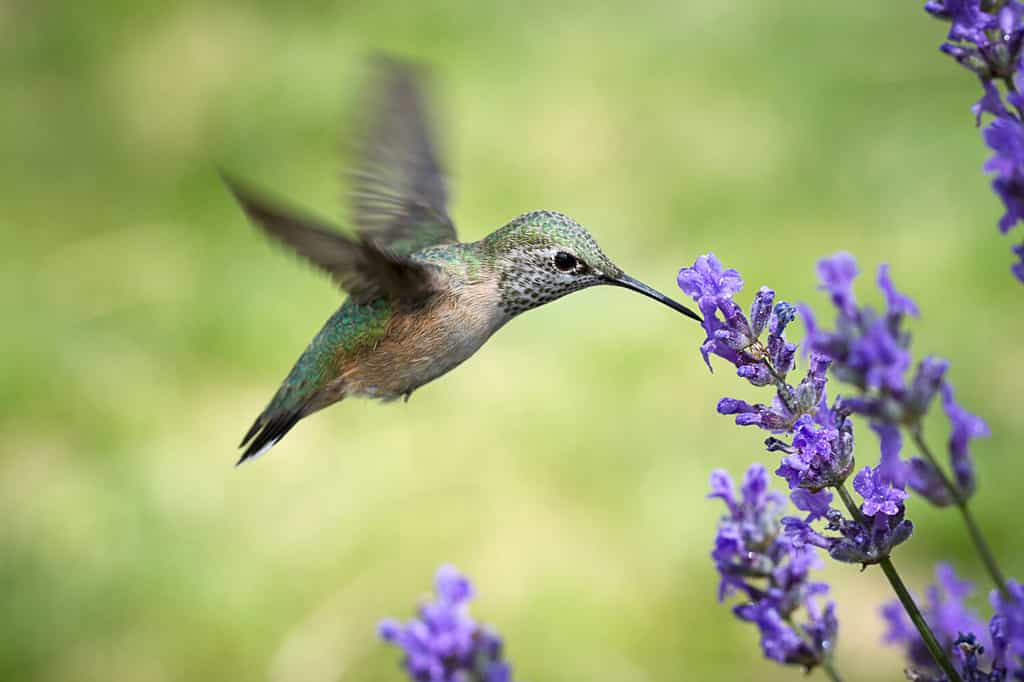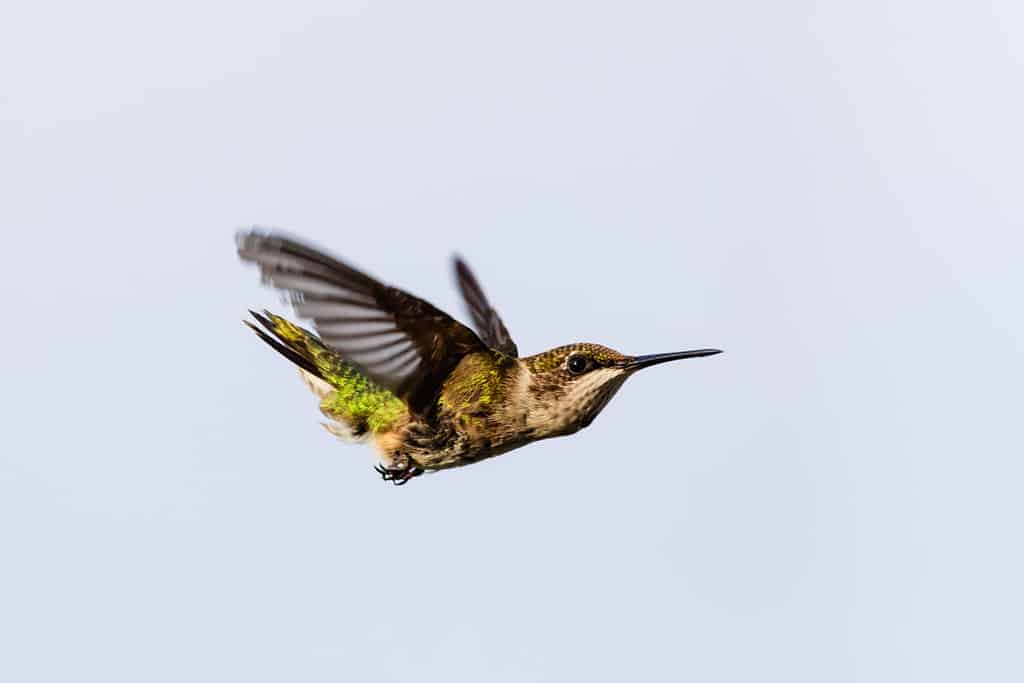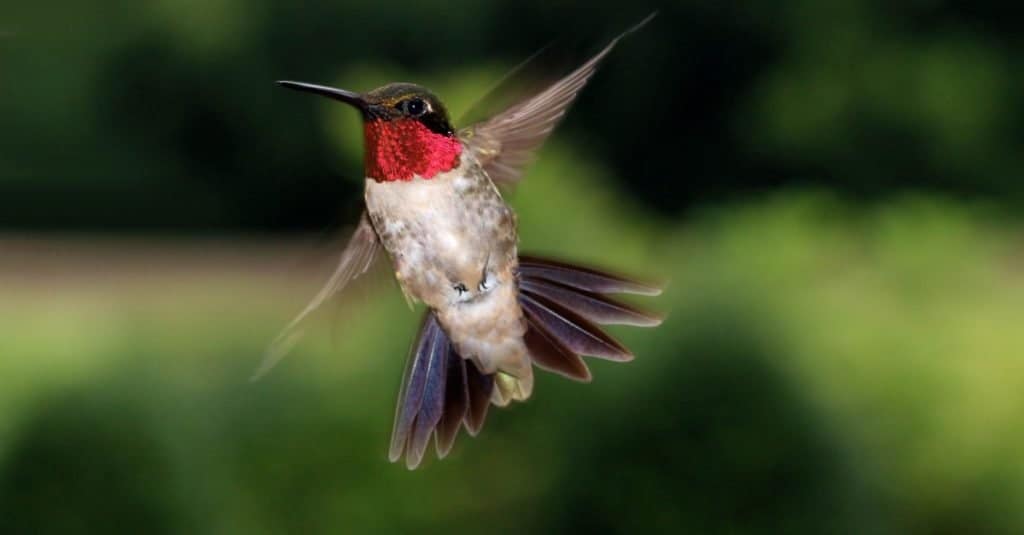Hummingbirds are incredibly beautiful animals that have fascinating biology and behavior. Their iridescent feathers, bizarre tongues, hovering capabilities, and migratory patterns fascinate both the avid birder and average onlooker alike. This article will investigate hummingbirds in Illinois, determine when hummingbirds leave Illinois, and find out where they go.
What is a Hummingbird?
Biology

Some hummingbirds, like this female calliope hummingbird, have iridescent wings.
©Gregory Johnston/Shutterstock.com
Hummingbirds are captivating birds known for their vibrant colors, remarkable flying skills, and rapid wing beats that create a distinctive humming sound. Belonging to the family Trochilidae, these tiny creatures are native to the Americas, spanning North, Central, and South America. With a diverse array of over 300 species, each boasting distinct characteristics, hummingbirds are a testament to nature’s creativity.
These beautiful birds have a notably diminutive size, ranging from 2 to 5 inches (5 to 13 cm). Hummingbirds exhibit an exquisite iridescence in their plumage that they achieve through microscopic feather platelets that refract light. They exemplify their outstanding flying abilities with their unique hovering technique. They hover by rapidly flapping their wings in a figure-eight motion. This skill allows them to delicately extract nectar from flowers, which is their primary food source. Their high metabolism demands a substantial intake of this nectar as well as insects.
Distribution

Hummingbirds live in varying habitats throughout the Americas.
©Bonnie Taylor Barry/Shutterstock.com
Hummingbirds’ global distribution spans the Americas, from the northern reaches of Alaska to the southern tip of Tierra del Fuego. Thriving most abundantly in tropical and subtropical regions, these birds are particularly diverse in countries like Colombia, Ecuador, and Peru, where a rich variety of flowering plants supports their nectar-based diet.
Migration patterns among hummingbird species are diverse. While some remain sedentary year-round, others embark on journeys influenced by changing seasons, resource availability, and daylight duration. Altitudinal migration sees them traverse mountains in search of blooming flowers, while long-distance migrations, such as those undertaken by the ruby-throated hummingbird from North America to Central America, involve more arduous journeys. These migrations are not without challenges, including the need to find suitable resting and feeding grounds, and the risks posed by predators and adverse weather conditions.
Where in Illinois do Hummingbirds Live?
In Illinois, hummingbirds can be found primarily in the southern and central regions of the state, particularly during their breeding season in the warmer months. They are most abundant in areas that offer a suitable combination of flowering plants, open spaces, and suitable nesting sites. While their presence can be observed throughout the state, the southern parts of Illinois, characterized by a milder climate and a greater variety of flowering plants, tend to host a larger population of these remarkable birds.

Hummingbirds in Illinois live in uninhabited areas and in suburbs or urban areas where they feed in gardens or on bird feeders.
©Jeff Westhead/Shutterstock.com
Within Illinois, hummingbirds can be found in a variety of habitats that provide the necessary resources for their survival. They often inhabit gardens, parks, and areas with a diverse array of flowering plants, which serve as vital sources of nectar for their energy needs. Woodlands with clearings, meadows, and fields with a mixture of wildflowers are also favorable habitats. Hummingbirds are attracted to both native and cultivated flowers, as long as they provide ample nectar. Urban and suburban areas with well-tended gardens and flowering plants can also attract these tiny avian wonders, offering them a source of sustenance and a place to nest.
When Do Hummingbirds Leave Illinois?
In Illinois, the departure of hummingbirds marks a significant seasonal transition, typically occurring in late summer to early fall, primarily during late August, and the months of September and October. This migration is prompted by a combination of environmental factors and instinctual cues ingrained in these tiny birds’ biology.
Why Do Hummingbirds Migrate?

Hummingbirds migrate incredible distances based on seasonal indicators.
©Donald T. Devine/Shutterstock.com
As the days gradually shorten and temperatures begin to drop, Illinois experiences a shift in its natural circadian rhythms. The decreasing daylight hours serve as a critical signal for many bird species, including hummingbirds, to initiate their migratory journey. Additionally, the decreasing availability of nectar-rich flowers due to changing plant blooming patterns plays a vital role. As these primary food sources wane, hummingbirds are compelled to seek new areas with abundant nectar to sustain them during their long migratory flights.
The phenomenon of migration is deeply ingrained in hummingbird genetics. Their internal biological clocks respond to the changing photoperiod. It triggers hormonal changes that prompt the birds to accumulate energy reserves for the upcoming journey. This energy stockpile fuels their impressive non-stop flights, sometimes spanning thousands of miles.. While the specific cues that trigger migration are complex and can vary between species, the synchronized response to environmental changes is a remarkable adaptation.
Where Do Hummingbirds Go When They Leave Illinois?

The male red-throated hummingbird is common in Illinois.
©Ramona Edwards/Shutterstock.com
When hummingbirds depart Illinois during their migratory season, they embark on remarkable journeys across North, Central, and South America. Many hummingbird species that breed in Illinois migrate to warmer regions for the winter. Here, they can find a consistent supply of nectar and insects. Some may travel to Central America. Countries include Mexico, Costa Rica, and Panama, while others venture further south to regions in South America.
In these overwintering areas, hummingbirds benefit from the availability of flowers that bloom year-round due to the milder climates. This ensures a stable source of nectar to sustain them throughout the winter months when food resources might be scarce in their breeding grounds. The migratory routes and destinations vary depending on the specific species of hummingbird. The ruby-throated hummingbird is common in Illinois. It migrates to Central America, including Mexico, for the winter.
The photo featured at the top of this post is © Cavan-Images/Shutterstock.com
Thank you for reading! Have some feedback for us? Contact the AZ Animals editorial team.






